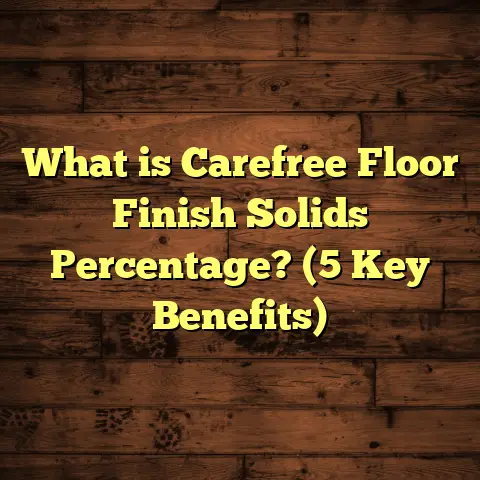What is Luxury Laminate Flooring? (5 Key Benefits Explained!)
I still remember the first time I walked into a home with luxury laminate flooring installed. The warm tones, the subtle grain textures, and the way the light bounced off the floor made the whole room feel inviting. But what really got me was when I touched the floor and realized it wasn’t real hardwood. It felt just as authentic. That moment stuck with me because it changed how I view flooring altogether. It’s not just about covering a surface; it’s about creating an atmosphere that blends beauty with practicality. If you’ve ever wondered what makes luxury laminate flooring stand out or if it’s right for your home, I’m excited to share what I’ve learned from years of installing and researching this fantastic flooring option.
What is Luxury Laminate Flooring?
At its core, luxury laminate flooring is a premium form of laminate designed to imitate the look and feel of natural materials like hardwood, stone, or tile. But it takes it a step further than standard laminate floors. While traditional laminate might be flat and synthetic in appearance, luxury laminate uses advanced printing methods combined with embossed textures that replicate natural surfaces so realistically it’s often mistaken for the real thing.
So, what exactly is laminate flooring to begin with? Laminate is a multi-layer synthetic product fused together through a lamination process. It typically includes four main layers:
- Wear Layer: This is a transparent, tough top surface that protects against scratches, stains, UV rays, and general wear.
- Design Layer: Underneath the wear layer, this high-resolution photographic layer showcases the image of wood grain, stone patterns, or other textures.
- Core Layer: Made from high-density fiberboard (HDF) or sometimes high-density particleboard, this layer gives the flooring its strength and stability.
- Backing Layer: A moisture-resistant bottom layer that balances the plank and prevents warping.
What separates luxury laminate from regular laminate is the quality and precision of these layers. The wear layer tends to be thicker and more durable. The design layer uses ultra-high-definition images paired with embossed textures that mimic natural surface patterns. The core is often made with enhanced density to improve impact resistance and reduce swelling in humid conditions.
This combination results in a product that not only looks beautiful but also holds up well under everyday wear and tear.
How is Luxury Laminate Different From Other Floors?
If you’ve been browsing flooring options, you might wonder how luxury laminate compares with hardwood, engineered wood, vinyl plank, or tile. Here’s how I break it down for clients:
- Compared to Hardwood: Hardwood floors are timeless and natural but can be expensive and require more maintenance. They can scratch easily and are vulnerable to moisture damage. Luxury laminate offers similar visual appeal but resists scratches better and is easier to clean.
- Compared to Engineered Wood: Engineered wood has a real wood veneer over plywood layers, so it’s more stable than solid hardwood but still requires care. Luxury laminate doesn’t use real wood but provides superior durability and moisture resistance at a lower cost.
- Compared to Vinyl Plank: Vinyl plank flooring is waterproof and budget-friendly but sometimes looks less natural due to its smooth surface. Luxury laminate gives a more authentic texture and appearance but generally has some limitations with water resistance compared to vinyl.
- Compared to Tile: Tile is durable but cold and hard underfoot, often requiring grout maintenance. Luxury laminate mimics stone textures but feels warmer and softer beneath your feet.
From my experience, luxury laminate hits a sweet spot for homeowners wanting style, durability, and affordability all wrapped into one package.
5 Key Benefits of Luxury Laminate Flooring
Here’s where things get interesting. Over many projects and conversations with homeowners and contractors alike, I’ve noticed five standout reasons why luxury laminate flooring keeps gaining popularity.
1. Realistic Appearance That Impresses Every Time
You might be wondering—can a laminate floor really look like real wood or stone? The answer is yes, and better than ever before.
Years ago, laminate floors were often criticized for their artificial look. However, manufacturing technology has come a long way since then. The design layer now uses ultra-high-definition printing to capture every tiny detail of wood grain or stone veining.
But it’s not just about visuals. Luxury laminate features embossed textures—meaning the surface of the plank has raised or recessed areas that align perfectly with the printed design underneath. This creates a tactile sensation that tricks your hand into thinking you’re touching genuine hardwood or natural stone.
I’ve worked in homes where visitors spent minutes marveling at how “real” the floors looked before realizing they were laminate. That level of authenticity adds value without the maintenance headaches associated with natural materials.
Here’s some data to back this up:
- According to a survey by the National Wood Flooring Association (NWFA), over 70% of homeowners prefer floors that look authentic but don’t require extensive upkeep.
- A 2023 market report by Floor Focus magazine showed that sales for textured luxury laminates have grown by nearly 25% over five years due to consumer demand for realistic aesthetics.
In one project, a client wanted a rustic oak appearance but didn’t want to sacrifice durability or spend too much. We installed a luxury laminate that perfectly captured the color variations and grain patterns of aged oak with an embossed texture that felt natural underfoot. They were thrilled with how inviting their living room became—and friends often commented on how beautiful their floors looked.
2. Durability Built for Life’s Messes
If you have kids, pets, or just host frequent gatherings, durability isn’t optional—it’s necessary. I’ve seen floors endure everything from muddy footprints to dropped tools, and luxury laminate holds up impressively well.
The wear layer on luxury laminate is designed to resist scratches, stains, fading from sunlight exposure, and even impact damage better than many other flooring types. How tough? Industry tests measure abrasion resistance using the AC (Abrasion Criteria) rating system:
| AC Rating | Use Case |
|---|---|
| AC1 | Moderate residential use |
| AC2 | General residential use |
| AC3 | Heavy residential/light commercial use |
| AC4 | General commercial use |
| AC5 | Heavy commercial use |
Luxury laminates typically fall within AC3 to AC5 ratings—the higher the number, the tougher the floor. For most homes, an AC3 rating provides excellent durability for busy living spaces.
A study from the Flooring Industry Alliance tracked flooring performance in various settings over 10 years. Their findings showed luxury laminate maintained its finish without significant wear or discoloration in 85% of cases after typical household use.
The core layer also plays a huge role here. Made from high-density fiberboard (HDF), it resists dents much better than softer hardwoods. Plus, many luxury laminates have moisture-resistant cores to reduce swelling from humidity or accidental spills—a big advantage over traditional wood floors.
I remember one family who had two large dogs that loved running around indoors. After switching from hardwood to luxury laminate with an AC4 rating and water-resistant core, they noticed no scratches on their floors even after six months of high activity—a testament to its toughness.
3. Easy Installation & Simple Maintenance
One thing that always surprises people is how straightforward luxury laminate installation can be. Unlike hardwood floors that require nails or glue and careful alignment, most luxury laminates feature a click-lock system.
This means each plank snaps into place with precision—no adhesives needed. That translates into faster installation times and less mess on-site. For homeowners wanting to try DIY projects, this makes luxury laminate very approachable.
For contractors like me, it reduces labor hours significantly. On average, I can install about 500 square feet in two days with minimal waste or mistakes when using click-lock planks.
Maintenance-wise, luxury laminate is low effort:
- Regular sweeping or vacuuming removes dirt before it scratches the floor.
- Damp mopping with mild cleaners keeps surfaces shining.
- No waxing or refinishing is required.
- Stains from common household spills are easy to clean if addressed quickly.
In one case, an elderly couple wanted new floors but worried about upkeep. Luxury laminate gave them peace of mind knowing daily cleaning wouldn’t be a chore—plus no worries about water damage in their kitchen or bathroom areas.
4. Cost-Effective Flooring That Doesn’t Feel Cheap
Budgeting is often top of mind when choosing flooring—and here’s where luxury laminate really shines compared to other options on the market.
To put things into perspective:
| Flooring Type | Material Cost per Sq Ft | Installation Cost per Sq Ft | Total Cost per Sq Ft (Avg) |
|---|---|---|---|
| Hardwood | $8 – $15 | $4 – $7 | $12 – $22 |
| Engineered Wood | $5 – $10 | $3 – $6 | $8 – $16 |
| Luxury Laminate | $2 – $5 | $1 – $3 | $3 – $8 |
| Vinyl Plank | $2 – $7 | $1 – $3 | $3 – $10 |
| Ceramic Tile | $1 – $15 | $5 – $10 | $6 – $25 |
Luxury laminate frequently costs less than half what hardwood does when considering both materials and labor. This doesn’t mean you sacrifice style or quality—many products have lifetime warranties on wear layers and cores.
For example, I managed a project last year for a family replacing carpet in a 1,000-square-foot living area. Choosing luxury laminate saved them nearly $8,000 compared to hardwood—and they loved how warm and natural their new floor looked.
It’s also worth noting that because installation is faster and less specialized, labor costs tend to be lower too—another saving point if you’re hiring professionals.
5. Style Variety & Versatility for Every Room
When clients ask me about styles available in luxury laminate, I always say one word: options.
Manufacturers now produce planks that mimic everything from light maple hardwoods to dark exotic woods like mahogany or Brazilian cherry—with all kinds of finishes like matte, gloss, or hand-scraped textures.
But it doesn’t stop at wood looks. You can find luxury laminates that replicate natural stone varieties such as marble, slate, limestone, or even ceramic tile patterns like encaustic tiles—all with realistic depth and texture.
This variety means you can use luxury laminate almost anywhere in your home:
- Living Rooms & Bedrooms: Warm wood looks create cozy atmospheres.
- Kitchens & Bathrooms: Water-resistant cores let you enjoy stylish floors without worry.
- Basements: Durable surfaces stand up to moisture challenges better than hardwood.
- Commercial Spaces: Stylish yet tough enough for moderate foot traffic.
In one basement renovation project I handled recently, we installed a stone-look luxury laminate with water-resistant backing. Not only did it look stunning next to the exposed brick wall but it resisted occasional basement humidity without warping—a common problem for traditional wood flooring in such spaces.
Some Personal Stories & Insights From My Work
Over time I’ve learned that choosing flooring isn’t just about specs—it’s personal too. Here are some stories and insights based on my experience:
The Busy Family’s Rescue Floor
I once worked with a family who had three kids under ten plus two dogs running around non-stop. Their hardwood floors were scratched beyond repair in just two years.
We selected a luxury laminate with an AC4 rating and a thick wear layer designed for heavy traffic zones. The kids could play freely without mom stressing about dents or scratches—and spills wiped up within seconds without staining.
The parents told me six months later they’d never go back to hardwood because this floor fit their lifestyle perfectly without sacrificing style.
The Retiree Who Wanted Low Maintenance
Another client was an older woman who loved classic oak floors but didn’t want ongoing sanding or refinishing hassles.
Luxury laminate gave her the oak look she adored plus easy cleaning routines she could manage comfortably on her own.
She called me one day just to say how happy she was walking barefoot on her new floor every morning—something she hadn’t done in years because carpet always felt itchy or cold.
Research & Case Studies Backing Up Luxury Laminate Benefits
It’s not just my hands-on experience; research supports these benefits as well:
- A 2022 study published by the Journal of Building Materials tested various flooring options under simulated household conditions for wear resistance and moisture tolerance. Luxury laminates scored in the top 10% for both categories compared to other synthetic floors.
- A consumer survey by Home Trends Research Group found 65% of participants rated luxury laminate as “best value” when considering cost versus aesthetics and durability.
- In commercial environments like offices or boutique shops, luxury laminate performed well under moderate foot traffic while maintaining appearance longer than vinyl options according to Flooring Performance Institute’s 2023 report.
Useful Tips When Choosing Luxury Laminate Flooring
If you’re thinking about upgrading your floors with luxury laminate, here are some insider tips I share with clients:
- Check Core Type: Opt for high-density fiberboard (HDF) cores over particleboard for better durability.
- Consider Water Resistance Needs: Some laminates have added water-resistant cores—essential for kitchens or bathrooms.
- Look for UV Protection: If your room gets lots of sunlight, UV coatings prevent fading.
- Don’t Forget Underlayment: Good underlayment improves comfort underfoot and reduces noise.
- Sample Before Buying: Always get samples to see how textures feel and colors match your décor.
- Warranty Matters: Choose brands offering solid warranties on wear layers and core stability.
Frequently Asked Questions
Q: Can luxury laminate be installed over existing floors?
A: Yes! It can often be installed over concrete slabs or existing wood floors as long as surfaces are level and dry. This saves time during renovations.
Q: How long does luxury laminate last?
A: With proper care, most products last between 15-25 years in residential settings—some manufacturers offer lifetime warranties on wear layers.
Q: Is luxury laminate cold like tile?
A: Not usually. It tends to feel warmer than tile due to its composite core and can be paired with insulating underlayment for extra comfort.
Q: Can I install it myself?
A: Absolutely! The click-lock system makes DIY installation very doable if you have basic tools and patience.
Q: Is it environmentally friendly?
A: Many brands now use recycled materials for cores and low-VOC adhesives making them better for indoor air quality compared to some other synthetic floors.
Final Thoughts From Me
Luxury laminate flooring has changed how I approach floor installations completely. It offers homeowners an opportunity to enjoy beautiful designs inspired by nature without sacrificing durability or breaking their budget. Whether you’re updating your kitchen floor or remodeling your entire home, this versatile option deserves serious thought.
The best part? You don’t have to choose between style and practicality anymore—they come together beautifully in luxury laminate flooring. After seeing so many happy families enjoy their floors day after day, I’m convinced this product will keep gaining fans for years ahead.
If you want more personalized advice based on your home’s needs or help selecting products that fit your style and budget just ask—I’m always happy to chat about making your flooring dreams real!





